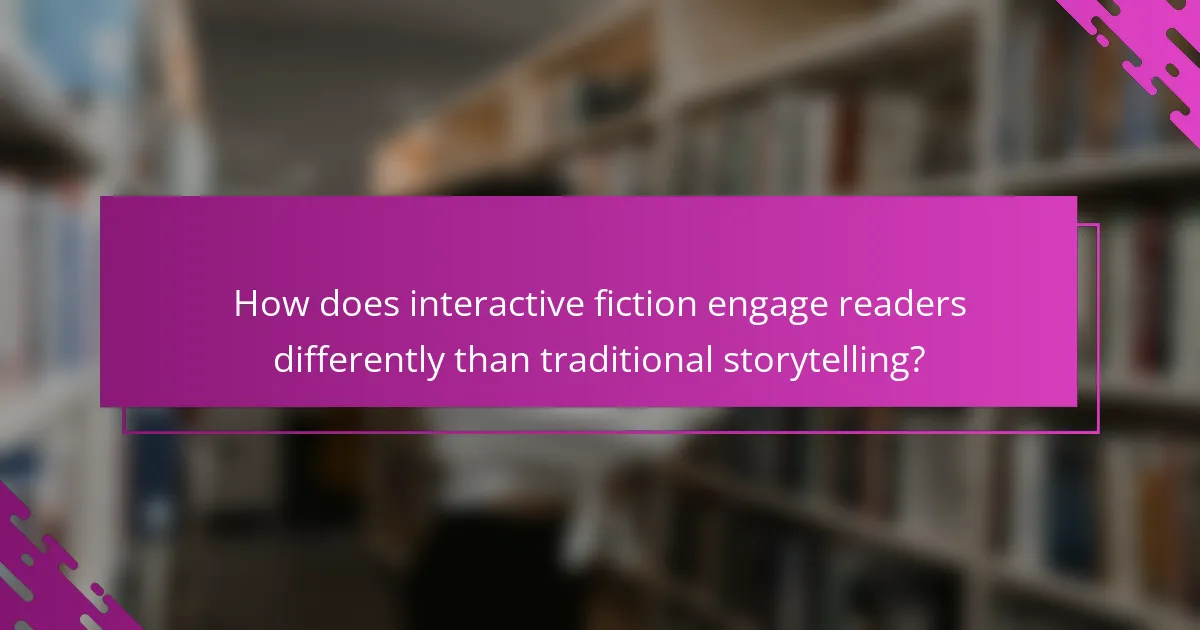Interactive fiction allows readers to shape narratives through their choices, enhancing engagement and emotional investment. This article explores platforms like Twine and ChoiceScript, highlights the immersive storytelling of successful titles, examines the challenges creators face, and discusses cultural influences on the genre. Additionally, it looks at the future of interactive fiction, including the integration of immersive technologies and community-driven storytelling.

How does interactive fiction engage readers differently than traditional storytelling?
Interactive fiction engages readers by allowing them to make choices that influence the story’s outcome. This interactivity fosters a sense of agency and personal investment that traditional storytelling lacks. Readers become active participants, shaping narratives through their decisions. This unique attribute enhances emotional engagement, creating a more immersive experience compared to passive reading. Additionally, platforms for interactive fiction, such as Twine and ChoiceScript, facilitate diverse storytelling forms that cater to varying reader preferences.
What are the core elements that define interactive fiction?
Interactive fiction is defined by its interactive narrative, player agency, and branching storylines. Key elements include choices that affect outcomes, immersive storytelling, and often a text-based interface. Platforms range from web-based applications to specialized software like Twine or Inform. Engagement with readers is heightened through personalized experiences and the exploration of unique story paths.
Why do readers prefer interactive fiction over other genres?
Readers prefer interactive fiction because it offers immersive experiences that engage them actively in the storytelling process. This genre allows for personal agency, where choices influence outcomes, creating a unique narrative journey. The interactivity fosters deeper emotional connections and enhances replayability, appealing to those seeking dynamic and personalized content. Additionally, platforms for interactive fiction, such as Twine and ChoiceScript, facilitate easy access and creation, further boosting its popularity among readers.

Which platforms are most popular for interactive fiction in 2025?
In 2025, popular platforms for interactive fiction include Twine, Ink, ChoiceScript, and StoryNexus. These platforms enhance reader engagement through user-friendly interfaces and diverse storytelling options. Twine offers visual storytelling, while Ink focuses on narrative flexibility. ChoiceScript allows for complex branching paths, and StoryNexus supports community-driven content creation. Each platform caters to different preferences, ensuring a rich interactive experience.
How do mobile applications enhance the interactive fiction experience?
Mobile applications enhance the interactive fiction experience by providing immersive storytelling, user-friendly interfaces, and dynamic content updates. They allow readers to engage with narratives through choices, multimedia elements, and social sharing features. Additionally, mobile apps can leverage unique attributes like location-based storytelling, enhancing the overall engagement and personalization of the experience. These attributes create a more interactive and captivating environment for readers.
What role do web-based platforms play in the accessibility of interactive fiction?
Web-based platforms significantly enhance the accessibility of interactive fiction by providing diverse entry points for readers. These platforms enable easy access to a wide range of narratives, often incorporating user-friendly interfaces that cater to various skill levels. They facilitate community engagement through comments and discussions, enriching the reader experience. Additionally, web-based platforms support multimedia elements, such as images and sounds, which deepen immersion and engagement. This accessibility fosters a broader audience, allowing creators to reach and interact with more readers than traditional formats.

What unique features set apart successful interactive fiction titles?
Successful interactive fiction titles stand out through their immersive storytelling, player agency, and innovative use of multimedia. These features engage readers by allowing them to shape narratives through choices, creating a personalized experience. Additionally, successful titles often incorporate unique branching paths, enhancing replay value and emotional investment. The integration of rich world-building and character development further distinguishes them, fostering deeper connections with the audience.
How does user choice impact narrative development in interactive fiction?
User choice significantly shapes narrative development in interactive fiction by allowing personalized experiences. Players’ decisions influence plot progression, character relationships, and endings, creating a unique journey for each participant. This interactivity fosters deeper engagement, as players feel a sense of agency and investment in the story. Additionally, branching narratives emerge from user choices, enhancing replayability and encouraging exploration of alternative outcomes.
What innovative storytelling techniques are used in leading interactive fiction games?
Leading interactive fiction games utilize innovative storytelling techniques that enhance player engagement and immersion. These techniques include branching narratives, where players’ choices significantly alter the story’s direction, and dynamic character interactions that adapt based on player decisions. Additionally, multimedia elements such as visuals, sound, and text create a rich narrative experience. Real-time feedback mechanisms allow players to see the consequences of their actions immediately, fostering a deeper connection to the story. Finally, community-driven content enables players to contribute to the narrative, further enhancing engagement and personalization.

Which challenges do creators face when developing interactive fiction?
Creators of interactive fiction face various challenges, including narrative complexity, technical limitations, and audience engagement. Balancing branching storylines can be difficult, as it requires careful planning to maintain coherence. Technical skills are often necessary to utilize platforms effectively, which can be a barrier for some. Additionally, capturing and retaining reader interest in an interactive format poses unique hurdles, as creators must ensure that choices feel meaningful and impactful.
How do technological limitations affect the quality of interactive fiction?
Technological limitations can significantly hinder the quality of interactive fiction by restricting narrative depth and user engagement. Limited processing power affects the complexity of storylines, character development, and environmental interactivity. Additionally, insufficient graphics capabilities can diminish the immersive experience, making it challenging for readers to fully engage with the narrative. Furthermore, outdated platforms may lack features that enhance interactivity, such as responsive design or multimedia integration, ultimately impacting reader satisfaction and retention.
What are common pitfalls in narrative design for interactive fiction?
Common pitfalls in narrative design for interactive fiction include lack of player agency, convoluted plots, insufficient character development, and neglecting pacing. These issues can lead to disengagement and frustration.
1. Lack of player agency: Players often feel disconnected when their choices do not significantly impact the story.
2. Convoluted plots: Overly complex narratives can confuse players, detracting from enjoyment.
3. Insufficient character development: Weak character arcs can lead to a lack of emotional investment.
4. Neglecting pacing: Poor pacing disrupts the narrative flow, making it hard for players to stay engaged.

How is interactive fiction perceived across different cultures?
Interactive fiction is perceived differently across cultures, influenced by local storytelling traditions and technology access. In Western cultures, it often emphasizes player agency and narrative complexity, while in Eastern cultures, it may integrate elements of folklore and communal storytelling.
Cultural context shapes how interactive fiction is created and consumed. For example, in Japan, visual novels blend text with anime-style art, appealing to a specific audience. In contrast, Western developers may focus on branching narratives and character development.
Engagement levels vary as well; some cultures embrace interactive fiction as a mainstream form of entertainment, while others view it as a niche genre. This divergence reflects broader attitudes towards gaming and literature.
The global rise of digital platforms fosters cross-cultural exchanges, allowing diverse influences to enrich interactive fiction. As a result, the genre continues to evolve, reflecting a blend of cultural narratives and interactive experiences.
What cultural themes are prevalent in interactive fiction from various regions?
Cultural themes in interactive fiction vary widely across regions, reflecting local traditions and narratives. Common themes include folklore, social issues, and identity exploration. For example, Asian interactive fiction often draws on mythology, while Western narratives may focus on personal journeys and moral dilemmas. African interactive fiction frequently highlights community and resilience. These themes engage readers by immersing them in culturally rich experiences.
How do reader demographics influence the popularity of interactive fiction genres?
Reader demographics significantly influence the popularity of interactive fiction genres by shaping content preferences and engagement levels. Younger audiences often favor genres that incorporate technology and interactivity, leading to a rise in digital platforms for storytelling. Conversely, older readers may gravitate towards traditional narratives, affecting genre trends.
Gender also plays a role; studies indicate that female readers are more inclined towards romance and fantasy genres, while male readers often prefer action and adventure. This demographic insight informs publishers and creators about targeted marketing strategies and content development.
Cultural backgrounds further impact genre popularity. Diverse narratives resonate more with readers from varied cultural contexts, enhancing engagement and broadening audience reach. Understanding these demographic factors allows creators to tailor interactive fiction experiences that align with reader interests, ultimately driving popularity and success.

What future trends can we expect in the interactive fiction landscape?
Interactive fiction will increasingly incorporate immersive technologies like virtual reality and augmented reality. These advancements will enhance storytelling by allowing readers to engage more deeply with narratives. Additionally, AI-driven content generation will personalize experiences, adapting stories to individual preferences. The rise of community-driven platforms will foster collaborative storytelling, empowering users to create and share their narratives. Lastly, cross-platform accessibility will ensure that interactive fiction reaches a broader audience across devices.
How will advancements in technology shape interactive fiction storytelling?
Advancements in technology will significantly enhance interactive fiction storytelling by enabling immersive experiences. Innovations like virtual reality and artificial intelligence will allow readers to engage with narratives in unprecedented ways. These technologies facilitate personalized storylines and dynamic character interactions, creating a more engaging and participatory experience. Enhanced graphics and audio will further immerse users, making storytelling more vivid and impactful.
What emerging platforms could redefine how interactive fiction is consumed?
Emerging platforms like virtual reality, augmented reality, and interactive audio experiences could redefine interactive fiction consumption. These technologies enhance immersion and engagement, allowing readers to participate actively in narratives. For example, VR platforms enable users to explore story environments, while AR can overlay story elements onto the real world. Interactive audio platforms provide narrative-driven experiences through sound, engaging listeners in unique ways. These innovations will likely shift user expectations and interaction methods with stories.
What best practices should creators follow to enhance reader engagement in interactive fiction?
Creators should prioritize interactivity, character development, and immersive storytelling to enhance reader engagement in interactive fiction. Engaging readers requires offering meaningful choices that impact the narrative.
Incorporating diverse perspectives enriches the experience. For example, branching storylines allow readers to explore different outcomes, fostering a sense of agency. Additionally, pacing should be carefully managed to maintain suspense and interest.
Utilizing multimedia elements, such as visuals and sound, can elevate engagement by creating a more immersive atmosphere. Regular feedback and community involvement can also strengthen connections between creators and readers, encouraging ongoing participation.



